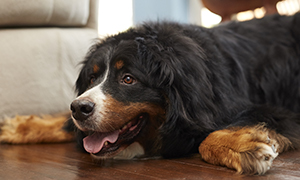Evaluation of the effects of a topical lipid formulation on the ultrastructural aspects of stratum corneum (SC) in normal and ichthyotic Golden retriever (GR) dogs (PNPLA1 mutation).

JL. MATHET1,2, E. GUAGUERE2, I. POPA3, C. NAVARRO4, C. ANDRE5 , J. PORTOUKALIAN6 and M. HAFTEK6
Abstract
Materials and Method
Animals: Ten Golden retriever (GR) dogs were recruited from two kennels - geographically close and with similar husbandry procedures - near Orléans, France:
5 unaffected GR dogs
5 PNPLA1 homozygously mutated GR dogs
Dogs were not washed neither received topical ointments for three weeks before the sampling.
The presence of mutations was assessed with the DNA screening test, ICT-A®, Antagene, La Tour de Salvagny, France.
Product: All dogs received a topical formulation, Allerderm Spot-On® (ADSO) (Virbac, France) containing ceramides, free fatty acids and cholesterol: 6 applications at 3 day intervals. A small
amount (50 μl) of the lipid-containing emulsion was smeared on an area of 4cm2 located on the inguinal fold and gently massaged for 15 seconds. Only one side was tested, the other side was used
as the reference.
Skin biopsies (4mm) were taken after local anaesthesia from both tested and non-tested inguinal areas: before the first application and one day after the final application of ADSO.
ADSO: showed stimulation of the production and secretion of endogenous SC lipids. Piekutowska et al (J. Comp. Pathol, 2008, 138, 197-208) and Popa et al (Clin. Exp. Dermatol, 2012, 37(6), 665-671) demonstrated that ALLERDERM Spot-On® restructures the SC lipid lamellae in atopic dogs and improves the disease-related lipid alterations.
Transmission electron microscopy (TEM) analysis:
- biopsies taken from both sides – tested and not tested
- post-fixed in: ruthenium tetroxide (RuO4) → lamellar lipids osmium tetroxide (OsO4) → lamellar bodies
- embedded in Epon resin
- ultrathin sections visualized with TEM
- photos taken with digital camera MegaView III
- intercellular spaces measured and analysed with AnalySIS system

PNPLA1 mutations cause autosomal recessive congenital ichthyosis in Golden Retriever dogs and humans, A Grall, E Guaguère et al, Nature Genetics, 2012, 44, 2: 140-149
Results

Conclusion
This is the first time that the effects of a topical epidermal lipid mixture on GR ichthyosis were ultrastructurally evaluated. As it was suggested in canine atopy, extrinsic lipids may be integrated in newly-elaborated lamellar bilayers, thus correcting the SC barrier defect.
In GR ichthyosis, the replenishment of the SC intercellular spaces and improvement of the lipid lamellar structures were only partially observed, probably due to the short period of application of Allerderm Spot-on® and the persisting enzymatic defect inheritant to this skin pathology. However, clinical improvement could be observed and the spot-on did modify proportions between the SC lipid fractions, as observed biochemically. It thus remains possible that better structural results could be observed if ADSO was applied for a longer time period. Long-term management of scaling in ichthyosis dogs may be a good target for such topical therapy, as clinical signs waxe and wane.
